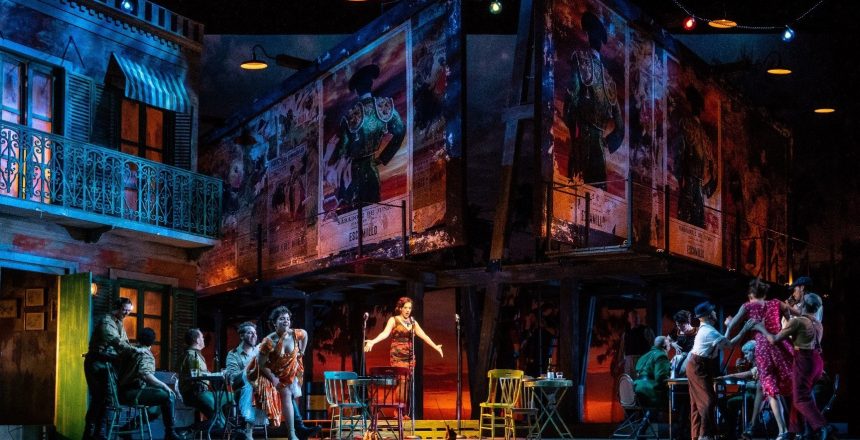
Paul Curran directed La Traviata for Opera Philadelphia in 2015 with some provocative updated images. It was Paris in the 1950s with dancers at Flora’s party doing the Charleston to Verdi’s gypsy music. While some viewers were appalled, I was impressed by its creativity.
He’s back at the helm of a new Carmen for Opera Philadelphia which will be shared with Seattle Opera and Irish National Opera.
Curran places it in the 1950s, indicated with movie posters and with military uniforms and longish dresses of that era (designed by Gary McCann.) Director Curran also says he intends to suggest “Havana, Miami or Seville,” not necessarily Spain. I respect Curran’s desire to broaden the appeal of Carmen, but the opera loses one of its strongest assets when he rejects the specific Navarraise and Basque character of the story and of Bizet’s music.
The title character has been portrayed in distinctly different ways — sometimes bold, sometimes intimate — as a teenaged spitfire, or a hardened slut, or a commanding presence, or elegant sophisticate. Each of those characterizations have been effective The personality of Daniela Mack’s Carmen, as directed by Curran, is not so defined. Rather, this is a middle-of-the-road, well-sung Carmen that is restrained rather than scorching. Her Habanera entrance is tame, and her tragic ending fails to move us.
The best illustration of poor direction is the final scene when Carmen sings to José, “Let me go!” and he is twenty feet away from her. Throughout most of their duets they stood far apart, with almost no in-your-face confrontation. Sexual chemistry was lacking too, despite the fact that both actors are young and attractive. For contrast, look at the video of those scenes with Elina Garanca and Roberto Alagna, directed by Richard Eyre at the Metropolitan Opera in 2009. In further contrast, some of us remember when Mario Del Monaco literally dislocated Risë Stevens’ shoulder during their final duet in 1954. (I’m not advocating physical violence, but these characters in such a situation should be on the verge of it.)
The tameness of this version of the character is a shame, because the talented Mack made an excellent impression in the two earlier operas I’ve seen her in.
Evan Leroy Johnson, a Curtis Institute student in his twenties, makes an appealing Don José with boyish demeanor and lovely head voice. As directed, he seems gawky and wimpy, and when he expressed concern about his mother back home, the audience laughed. The famed director Harold Prince said that “if an audience responds inappropriately, it’s our fault, not theirs.” Something in Johnson’s movement or facial expression, or the staging, caused viewers to think that José’s love for his mother was funny.
José is an educated man who studied for the priesthood and is in line for leadership in the army. He is a noble person of promise who throws all that away because of infatuation with Carmen. Don José must be shown as a flawed hero who has potential, then self-destructs. If a director allows him to appear ridiculous, the dramatic center disappears.
Vocally, too, an ideal Don José would have substantial power and heft in his voice. That’s what made Mario Del Monaco, Jon Vickers, Franco Corelli and, recently, Roberto Alagna, so good in the role. Johnson could use more of that.
Adrian Timpau as Escamillo makes his entrance on a motorcycle riding onto the floor of Lilas Pastia’s tavern, which looks silly, but he exudes such charisma that he pulls it off, and his Toreador Song is delivered with panache. Timpau, above everyone else in the cast, commands attention. Kirsten MacKinnon is tall, blonde and Grace Kellyish as Micaëla, the girl from José’s home town. She sings sweetly in her brief scenes.
Musa Nsqungwana lends authority as Zuniga and Ashley Milanese as Frasquita and Anastasiia Sidorva as Mercédès are excellent. Curran utilizes those women as part of a female vocal trio with Carmen in the tavern scene. The director has them stand on a stage and hold microphones as if they are the Supremes as they sing Bizet’s music. He should have gone a step further and placed back-up dancers behind them, like a Motown act. Instead, a few hoofers perform on the periphery.
The most interesting innovation in the production is setting Act III in a large warehouse instead of outdoors in the mountains. The change makes sense as it shows dozens of smugglers handling large crates; yet it isn’t clear if it adds anything to the drama. Curran’s Act IV has the most excitement as he colorfully presents the bullfighters’ march. The moves of the picadors and banderilleros are picturesque and the crowd reactions are enthusiastic.
Yves Abel leads the orchestra with graceful French style, imparting special warmth to the preludes before Acts II and III. The choruses (men, women, children) perform exceptionally well, as trained by Elizabeth Braden.
Originally, Carmen was presented with considerable spoken dialogue. But most opera houses soon replaced the dialogue with musical additions by Ernest Guiraud. In recent decades, the spoken scenes have won new favor. I wish this production had used at least some of them, because they add specificity and subtlety and I’ll bet the actors would enjoy the opportunity, even though it’s hard to project spoken words to a large opera house in a natural manner.